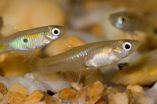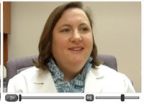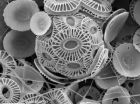(Press-News.org) DURHAM, N.C. -- Step aside copper and make way for a better carrier of information -- light.
As good as the metal has been in zipping information from one circuit to another on silicon inside computers and other electronic devices, optical signals can carry much more, according to Duke University electrical engineers. So the engineers have designed and demonstrated microscopically small lasers integrated with thin film-light guides on silicon that could replace the copper in a host of electronic products.
The structures on silicon not only contain tiny light-emitting lasers, but connect these lasers to channels that accurately guide the light to its target, typically another nearby chip or component. This new approach could help engineers who, in their drive to create tinier and faster computers and devices, are studying light as the basis for the next generation information carrier.
The engineers believe they have solved some of the unanswered riddles facing scientists trying to create and control light at such a miniscule scale.
"Getting light onto silicon and controlling it is the first step toward chip scale optical systems," said Sabarni Palit, who this summer received her Ph.D. while working in the laboratory of Nan Marie Jokerst, J.A. Jones Distinguished Professor of Electrical and Computer Engineering at Duke's Pratt School of Engineering.
The results of team's experiments, which were supported by the Army Research Office, were published online in the journal Optics Letters.
"The challenge has been creating light on such a small scale on silicon, and ensuring that it is received by the next component without losing most of the light," Palit said.
"We came up with a way of creating a thin film integrated structure on silicon that not only contains a light source that can be kept cool, but can also accurately guide the wave onto its next connection," she said. "This integration of components is essential for any such chip-scale, light-based system."
The Duke team developed a method of taking the thick substrate off of a laser, and bonding this thin film laser to silicon. The lasers are about one one-hundreth of the thickness of a human hair. These lasers are connected to other structures by laying down a microscopic layer of polymer that covers one end of the laser and goes off in a channel to other components. Each layer of the laser and light channel is given its specific characteristics, or functions, through nano- and micro-fabrication processes and by selectively removing portions of the substrate with chemicals.
"In the process of producing light, lasers produce heat, which can cause the laser to degrade," Sabarni said. "We found that including a very thin band of metals between the laser and the silicon substrate dissipated the heat, keeping the laser functional."
For Jokerst, the ability to reliably facilitate individual chips or components that "talk" to each other using light is the next big challenge in the continuing process of packing more processing power into smaller and smaller chip-scale packages.
"To use light in chip-scale systems is exciting," she said. "But the amount of power needed to run these systems has to be very small to make them portable, and they should be inexpensive to produce. There are applications for this in consumer electronics, medical diagnostics and environmental sensing."
INFORMATION:
The work on this project was conducted in Duke's Shared Materials Instrumentation Facility, which, like similar facilities in the semiconductor industry, allows the fabrication of intricate materials in a totally "clean" setting. Jokerst is the facility's executive director.
Other members of the team were Duke's Mengyuan Huang, as well as Dr. Jeremy Kirch and professor Luke Mawst from the University of Wisconsin at Madision.
Light on silicon better than copper?
2010-10-22
ELSE PRESS RELEASES FROM THIS DATE:
Too many sisters affect male sexuality
2010-10-22
Growing up with lots of sisters makes a man less sexy. For rats, anyway. A new study published in Psychological Science, a journal of the Association for Psychological Science, finds that the sex ratio of a male rat's family when he's growing up influences both his own sexual behavior and how female rats respond to him.
David Crews, a psychobiologist at the University of Texas at Austin, is interested in how early life affects behavior later. This is an area that has received a lot of attention recently, such as research showing that the position of a fetus in the uterus ...
Strategies for translational research in the UK
2010-10-22
A commentary published in the journal, Science Translational Medicine, examines the structures of translational research investment in the UK.
The commentary has been written by researchers from the National Institute for Health Research (NIHR) comprehensive Biomedical Research Centre (BRC) at Guy's and St Thomas' and King's College London. The authors consider the results of substantial Government and charitable investment in translational research taking place within the NHS.
The commentary follows the progress of the research and development funding streams available ...
Poor start in life need not spell doom in adulthood
2010-10-22
RIVERSIDE, Calif. – Does the environment encountered early in life have permanent and predictable long-term effects in adulthood? Such effects have been reported in numerous organisms, including humans.
But now a biology graduate student at the University of California, Riverside reports that how individuals fare as adults is not simply a passive consequence of the limits that early conditions may impose on them. Studying how adult Trinidadian guppies (small freshwater fish) responded to their early food conditions, Sonya Auer found that the guppies had compensated ...
Researchers find better method to help mothers cope with child's cancer and related stress
2010-10-22
VIDEO:
Martha Askins explains problem-solving skills training.
Click here for more information.
BOSTON - Mothers who have children diagnosed with cancer now have a better approach to address and cope with stresses associated with their child's disease.
A new certified intervention has proven to be more effective long term compared to other psychological methods, as reported today at the 42nd Congress of the International Society of Pediatric Oncology.
In a joint ...
Study finds airbags reduce risk of kidney injury in car crashes
2010-10-22
CHICAGO (October 21, 2010) – Occupants in motor vehicles with airbags are much less likely to suffer kidney or renal damage in a crash than are occupants in vehicles without airbags, according to a new study in the September Journal of the American College of Surgeons.
Little is known about how to prevent or reduce injury to solid organs from motor vehicle collisions. In fact, this study is the first to evaluate the protective effect of airbags on a specific organ system – in this case, the kidney and other renal, or upper urinary tract, organs.
The researchers found ...
Telementoring may address need for surgical subspecialty expertise in remote locations
2010-10-22
CHICAGO (October 21, 2010) – Telementoring may be an effective way for subspecialist surgeons to assist remotely located general surgeons in the care of patients in need of emergency subspecialty surgical procedures, according to new research findings published in the September issue of the Journal of the American College of Surgeons.
In the study, eight general surgery residents with no formal subspecialty training participated in three mock operations using animal cadavers intended to simulate live procedures. When telementored, the residents achieved higher overall ...
Studies show everolimus-eluting stent implantation reduces restenosis and repeat revasculariztion
2010-10-22
Two new studies have determined that everolimus-eluting stent (EES) implantation reduced the incidence of restenosis and repeat revascularization in patients with calcified culprit lesions, and had fewer clinical events. Results show the rate of major cardiac adverse events in EES-treated patients with calcified lesions were higher than in those for noncalcified lesions, but remained lower than the results of previously reported stent studies. Details of both studies are published in the November issue of Catheterization and Cardiovascular Intervention, a peer-reviewed ...
The impact of chronic diseases on patients also depends on their perception of the disease
2010-10-22
What do we mean by "common sense" when we talk about a disease? What affects the ideas and beliefs that patients have of their disease? Researchers at the University of Granada have developed a test for measuring and assessing chronic patients' cognitive representation of their disease. This advance will enable the development of clinical psychological treatments much more efficient than those currently employed.
The cognitive representation of a disease is the ideas and beliefs that patients have in relation to their condition, at a given time. These ideas are based ...
Promising new 'antigene' therapy
2010-10-22
New Rochelle, NY, October 21, 2010—Antigene therapy is a promising new treatment strategy that uses a DNA-based drug to pinpoint light energy to a target gene shutting down its activity. A review article published online ahead of print in Oligonucleotides, a peer-reviewed journal published by Mary Ann Liebert, Inc. (www.liebertpub.com), details the possibilities and challenges for the clinical application of this novel photo-activated DNA modulating approach. The article is available free online at www.liebertpub.com/oli
Netanel Kolevzon and Eylon Yavin, from The Hebrew ...
Coccolithophore blooms in the southwest Atlantic
2010-10-22
A study led by Dr Stuart Painter of the National Oceanography Centre helps explain the formation of huge phytoplankton blooms off the southeast coast of South America during the austral summer (December-January). The region supports the highly productive Patagonian Shelf marine ecosystem, which includes a globally important fishery.
Coccolithophores are key members of the marine phytoplankton community. They are abundant in the sunlit upper layer of the world's oceans, often forming vast blooms that can be seen from space.
"Coccolithophores are a complex group of plankton ...



